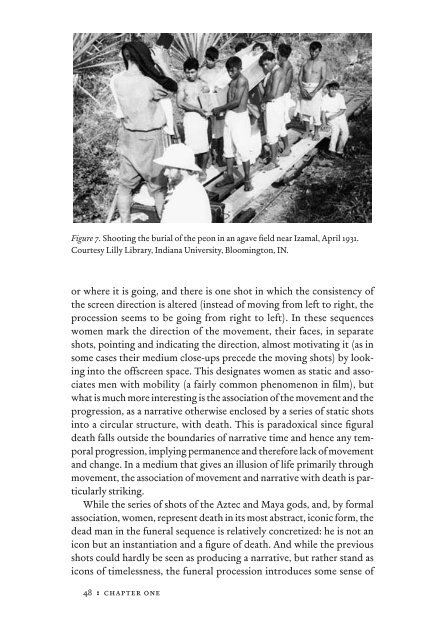In Excess: Sergei Eisentein's Mexico - Cineclub
In Excess: Sergei Eisentein's Mexico - Cineclub
In Excess: Sergei Eisentein's Mexico - Cineclub
You also want an ePaper? Increase the reach of your titles
YUMPU automatically turns print PDFs into web optimized ePapers that Google loves.
Figure 7. Shooting the burial of the peon in an agave fi eld near Izamal, April 1931.<br />
Courtesy Lilly Library, <strong>In</strong>diana University, Bloomington, IN.<br />
or where it is going, and there is one shot in which the consistency of<br />
the screen direction is altered (instead of moving from left to right, the<br />
procession seems to be going from right to left). <strong>In</strong> these sequences<br />
women mark the direction of the movement, their faces, in separate<br />
shots, pointing and indicating the direction, almost motivating it (as in<br />
some cases their medium close-ups precede the moving shots) by looking<br />
into the offscreen space. This designates women as static and associates<br />
men with mobility (a fairly common phenomenon in fi lm), but<br />
what is much more interesting is the association of the movement and the<br />
progression, as a narrative otherwise enclosed by a series of static shots<br />
into a circular structure, with death. This is paradoxical since fi gural<br />
death falls outside the boundaries of narrative time and hence any temporal<br />
progression, implying permanence and therefore lack of movement<br />
and change. <strong>In</strong> a medium that gives an illusion of life primarily through<br />
movement, the association of movement and narrative with death is particularly<br />
striking.<br />
While the series of shots of the Aztec and Maya gods, and, by formal<br />
association, women, represent death in its most abstract, iconic form, the<br />
dead man in the funeral sequence is relatively concretized: he is not an<br />
icon but an instantiation and a fi gure of death. And while the previous<br />
shots could hardly be seen as producing a narrative, but rather stand as<br />
icons of timelessness, the funeral procession introduces some sense of<br />
48 : chapter one


